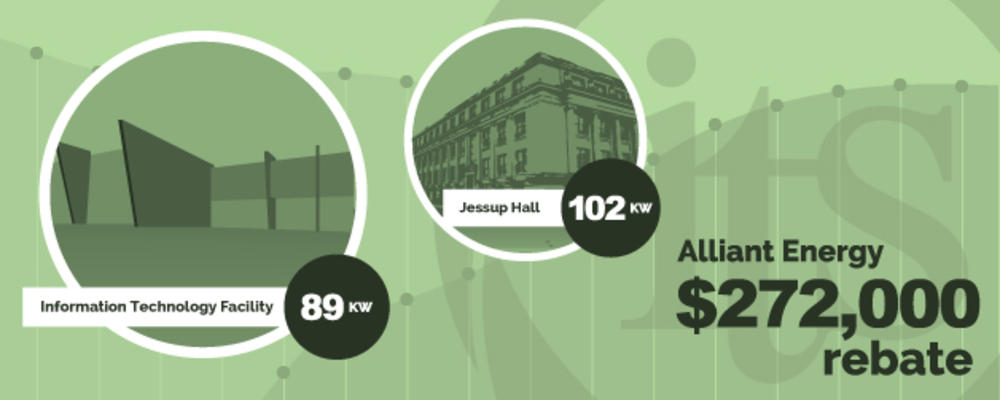
The University of Iowa is already seeing the benefits of a new energy-efficient data center, the first building on campus to achieve Leadership in Energy and Environmental Design (LEED) platinum certification.
Construction of the new Information Technology Facility (ITF) was completed in late 2011, providing a safe and secure location for the university’s vital IT infrastructure. Over the past year, staff from Information Technology Services (ITS) and Health Care Information Systems (HCIS) migrated hundreds of servers from smaller, less efficient data centers on campus.
The majority of those servers had been housed in antiquated data centers in the basement of Jessup Hall and the hospital, where the heating and cooling systems necessary to keep IT equipment at the proper temperature were significantly less efficient.
Sustainability was a top priority in the design and construction of the new data center. The UI took energy efficiency a step further with a combination of energy-efficient server purchases and server virtualization, which allows multiple systems to share a larger host. Server virtualization reduces overhead costs and allows for higher utilization of systems. Older server models were replaced by new ones with highly efficient power supplies and Energy Star-rated processors.
At its peak, in January of 2010, the Jessup Hall Data Center used an average of 102 kilowatts (KW) of electrical power. But even as the ITF came online and picked up the full workload of Jessup and more (additional storage and processing capacity), its current average power usage is only about 89 KW.
Projections by design consultants on the project indicated that the ITF would use 37% less energy than a building without energy-efficient upgrades, resulting in an energy savings of 1.5 million kilowatt-hours (KWH) a year, or about $203,000 in energy costs. That’s especially important, considering that ITF has significant capacity for and is the future home to energy-hungry research computing systems.
“There’s no doubt that building a new data center is a substantial investment at the outset, but we knew that building it with sustainable features was the right thing to do and that it would pay off in the long run,” said Jerry Protheroe, data center manager for ITS.
In addition to energy savings, the UI earned a rebate from Alliant Energy in the amount of $271,854 for participating in the Commercial New Construction program, which involved working with building designers right from the start to make sure all options for energy savings were analyzed.
The rebate money will help the university take IT energy conservation efforts to the next level. IT leaders, working with Facilities Management and the Office of Sustainability, have put together a data center optimization initiative to encourage units with less efficient data centers tucked in rooms and other data center spaces across campus to utilize the ITF. Funds from the rebate will be used to assist units in moving their server needs to ITF.
The university’s 2020 Vision for sustainability calls for achieving “net-negative energy growth,” meaning the campus would consume less energy in 2020 than in 2010, despite projected growth.
“We really see it as a win-win for units to take advantage of the new facility, even beyond the savings in utility costs,” said Guy Falsetti, who leads the ITS Server Support Team. “ITF is a professional-grade data center, there is less risk of equipment being affected by outside forces like flooding or severe weather, and departmental IT professionals will spend less time on facilities maintenance and management but still have the freedom to control their systems remotely.”
During the migration to ITF, ITS staff moved 537 servers. The project entailed changing Internet Protocol (IP) addresses and reconfiguring services for the new network, architecting firewalls and classifying data on the systems, and moving services and reworking systems for upgrades.
The UI officially closed the Jessup Hall data center in March. The 89-year-old building on the Pentacrest was home to the UI’s mainframe computer for over 50 years. The mainframe powered administrative records for decades, but those functions moved to new platforms upon completion of a new student record system, MAUI. It also supported the work of researchers like pioneering astrophysicist James Van Allen, who used it to crunch data from orbiting satellites. As new technology emerged, mainframe use wound down. It was powered down for the final time on April 1.
Now UI staff members are in the final stages of decommissioning and removing the old equipment from Jessup, and determining how the former data center space will be repurposed for other uses.